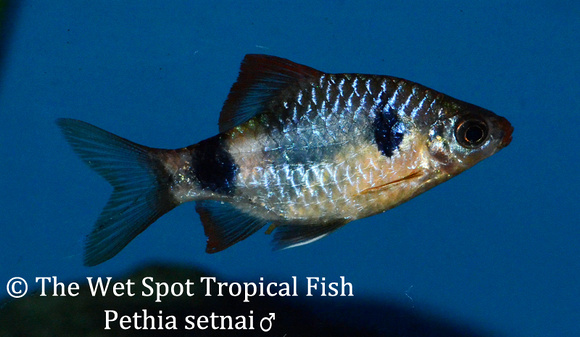July 18, 2014
July 18, 2014
•
Leave a Comment
July 18, 2014 Good day, friends! With nearly 300 species of fish known in the Western Ghats drainage and nearly half of them endemic and found nowhere else in the world, I felt it was prudent to continue our discussion of this amazing hotspot of biodiversity. As though the multitude of fish wasn’t enough, the Western Ghats Mountains are home to over 4,000 different flowering plants, 500 birds, almost 300 species of reptiles and amphibians, and 120 mammals.
Dawkinsia assimilis “Mascara Barb” is a close relative of the Rohan’s Tear Spot Barb mentioned last week. It originates in the same general geographic location and carries similar markings and body shape, as well as also being a riverine species and enjoying similar water parameters. However, the Mascara Barb is about an inch longer than the Rohan’s Tear Spot when full grown and has some marked differences in coloration. While the Rohani’s tail spot continues into the caudal fin proper, a distinct break occurs between the oval spot and the caudal fin in the Mascara Barb. Additionally, the Mascara’s caudal fins are tipped in black and red with the majority of the fin being devoid of color. The dorsal of adult males is bright red with little to no black coloration, though it does feature filamentous extensions. The most notable characteristic of the mascara barb is an oblong black spot over the eye, skewed towards the back of the gill plate. While still carrying iridescent scale edges over the dorsal half of the body, the base color of D. assimilis is much more yellow than that of D. rohani and contains some red scales, particularly along the lateral line. Finally, the ventral half of the body shows many iridescent blue scales.
Pethia setnai “Narayan’s Barb” is a plump two and a half inch schooling fish with a body shape akin to the ever-popular Tiger Barb. Females (as well as sub-adults and younger) are a beautiful cream color with distinct black bars behind the head and just before the caudal fin. A third diffused black bar marking occurs at the rear of the dorsal fin and extends down past the fish’s midline. The dorsal fin is touched with a hint of pumpkin orange and all other finnage is transparent. The slightly smaller and slimmer adult males feature persimmon red coloration over every fin as well as their dorsal edge, as well as brilliant white leading edges to their ventral fins. Like most barbs, Narayan’s Barb is quite peaceful and well-behaved and is suitable for nearly any community aquarium. P. setnai tends to congregate aside hillstreams in pools or slower-flowing deep areas. With a preference for low to mid 70s Fahrenheit, neutral pH and fairly low hardness, this fish epitomizes the mountain drainages it hails from. Garra flavatra, the “Panda Garra”, is a beautiful addition to any moderately-sized Western Ghats hillstream tank. This sucker-mouthed cyprinid has a beautiful olive-brown coloration with defined dark scale edges, ribbons of yellow across its dorsal edge, and brilliant red unpaired fins. Its underslung mouth is used to scrape algae and awfwuchs from smooth rocks and surfaces, though it also enjoys a treat of meaty foods such as bloodworms and other invertebrates. A maximum length of about three and a half inches makes a small group of this shoaling fish suitable for an aquarium with a three foot footprint. As a shoaling species, the Panda Garra may be territorial with other fish of a similar shape to them, such as Ancistrus, gobies, or loaches. To avoid these squabbles, a group of G. flavatra should be kept, allowing them to establish a pecking order and bicker amongst themselves for territories. A neutral pH and temperatures between 70 and 80 degrees Fahrenheit will suit the Panda Garra.
Laubuca dadiburjori “Orange Hatchet” is a schooling Cyprinid that prefers to occupy the upper levels of the aquarium. It has a lovely orange-yellow coloration with an iridescent blue line running laterally from nose to tail. As the line approaches the fish’s head, it becomes broken into a series of spots on many specimens. Its pectoral fins are reminiscent of a true hatchetfish with an upturned angle; however, it is not a true hatchet. It is a unique little fish for any suitable Western Ghats biotope aquarium lacking in upper level excitement. Adults are just over an inch in length when full grown and the species prefers low to mid-70s temperatures and neutral pH values. With the end of today, Lia will move on to greater things in her life. Her position as our Sales Associate and Phone Representative has passed to Chelsea and I do hope you will give her a warm welcome. With the help of Chelsea and our new Floor Associate, Gabe, Anthony and I can continue to supply you with the best quality freshwater fish in the country. If you have any comments or constructive criticism on our test newsletter format, please do let me know. Thank you for reading and I’ll see you back here next week! Jessica Supalla
Keywords:
Newsletter
Comments
No comments posted.
Loading...
|





